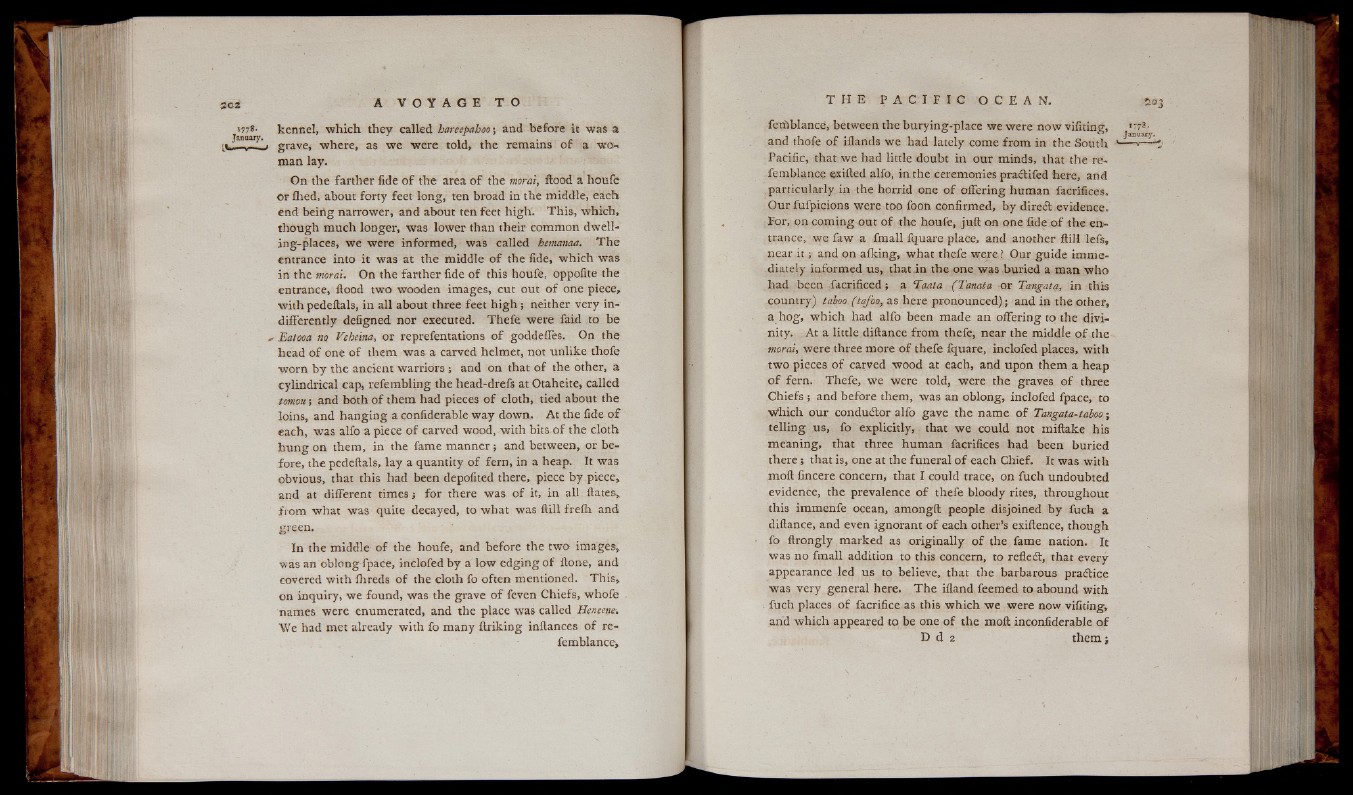
kennel, •which they called hareepahoo; and before it was a
grave, where, as w e w ere told, the remains o f a woman
lay.
On the farther fide o f the area o f the moral, flood a houfe
Or ihed, about forty feet long, ten broad in the middle, each
end being narrower, and about ten feet high . T h is , w hich,
thou gh much longer, was lowe r than their common dwelling
places, w e were informed, was called hemanaa. T h e
entrance into it was at the middle o f the fide, w hich was
in the moral. On the farther fide o f this houfe, oppofite the
entrance, flood two wooden images, cut out o f one piece,
w ith pedeftals, in all about three feet h igh ; neither ve ry indifferently
defigned nor executed. T he fe were faid to be
- Eatooa no Veheina, or reprefentations o f goddeffes. On the
head o f one o f them was. a carved helmet, not u n lik e thofe
worn b y the ancient warriors ; and on that o f the other, a
cylindrical cap, refembling the head-drefs at Otaheite, called
tomou; and both o f them had pieces o f cloth, tied about the
loins, and h an g in g a confiderable w a y down. At the fide o f
each, was alfo a piece o f carved wood, w ith bits o f the cloth
h u n g on them, in the fame manner ; and between, or before,
the pedeftals, la y a quantity o f fern, in a heap. It was
obvious, that this had been depofited there, piece by piece,
and at different times j fo r there was o f it, in all ftates,
from what was quite decayed, to what was ftill frefh and
green.
In the middle o f the houfe, and before the two. images,
was an oblong fpace, inclofed b y a low edgin g o f ftone, and
covered with fhreds o f the cloth fo often mentioned. T his ,
on inquiry, w e found, was the grave o f feven Chiefs, w hofe
names were enumerated, and the place was called l lm t e n t .
We had met already with fo many ftriking inftances o f refemblance,
ferilblance, between the burying-place we were n ow vifiting, J'?s-
and thofe o f iilands w e had lately come from in the South >
Pacific, that we had little doubt in our minds, that the re-
femblance ©xifted alfo, in the ceremonies pradlifed here, and
particularly in the horrid one o f offering human facrifices.
Our fufpicions were too foon confirmed, b y diredt evidence.
For, on comin g out o f the houfe, juft on one fide o f the entrance,
we faw a fmall fquare place, and another ftill lefs,
near i t ; and on a ik in g , what thefe were ? Our gu ide imme diately
informed us, that .in the one was buried a man who
had been fac r ificed ; a Taata (Tanata or Tangata, in this
country) taboo (tafio,, as here pronounced); and in the other,
a hog, w hich had alfo been made an offering to the divinity.
At a little diftance from thefe, near the middle o f the
moral, were three more o f thefe fquare, inclofed places, w ith
two pieces o f carved wood at each, and upon them a heap
o f fern. Thefe, we were told, were the graves o f three
Chiefs ; and before them, was an oblong, inclofed fpace, to
Which our conductor alfo ga ve the name o f Tangata-taboo;
te llin g us, fo explicitly, that w e could not miftake his
meaning, that three human facrifices had been buried
th e r e ; that is, one at the funeral o f each Chief. It was with
moft fincere concern, that I could trace, on fuch undoubted
evidence, the prevalence o f thefe bloody rites, throughout
this immenfe ocean, amongft people disjoined b y fuch a
diftance, and even ignorant o f each other’s exiftence, though
fo ftrongly marked as o rig ina lly o f the fame nation. It
was no fmall addition to this concern, to refledt, that every
appearance led us to believe, that the barbarous praftice
was ve ry general here. T h e ifland feemed to abound with
fuch places o f facrifice as this w h ich w e were now vifiting,
and w hich appeared to be one o f the moft inconfiderable o f
D d 2 th em ;